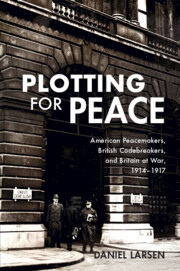Book contents
- Plotting for Peace
- Plotting for Peace
- Copyright page
- Dedication
- Contents
- Figures
- Map
- Graph and Table
- Dramatis Personae
- Preface
- Acknowledgements
- Maps
- Introduction
- 1 The First Year of War
- 2 Strategy
- 3 Negotiations
- 4 Deliberations
- 5 The Gamble
- 6 The Knock-Out Blow
- 7 The Fall of Asquith
- 8 Peace Moves
- 9 The Zimmermann Telegram and Wilson’s Move to War
- Conclusion
- Book part
- Notes
- Bibliography
- Index
6 - The Knock-Out Blow
September–October 1916
Published online by Cambridge University Press: 26 March 2021
- Plotting for Peace
- Plotting for Peace
- Copyright page
- Dedication
- Contents
- Figures
- Map
- Graph and Table
- Dramatis Personae
- Preface
- Acknowledgements
- Maps
- Introduction
- 1 The First Year of War
- 2 Strategy
- 3 Negotiations
- 4 Deliberations
- 5 The Gamble
- 6 The Knock-Out Blow
- 7 The Fall of Asquith
- 8 Peace Moves
- 9 The Zimmermann Telegram and Wilson’s Move to War
- Conclusion
- Book part
- Notes
- Bibliography
- Index
Summary
The optimism within the government steadily receded. Some ministers began to grapple with the reality of the failure of British war strategy, while others remained in emphatic denial of their growing US economic problem. Although some within the government remained tempted by the possibility of American mediation, Montagu aimed to offer an alternative way forward, seeking to build new munitions factories. This would enable the Allies to continue the war even after a radical wind-down in their American purchasing. Lloyd George, however, stridently opposed any reductions in their US spending. He also abruptly became a vehement opponent of American mediation when he was shown misleading intelligence that seemed to reveal secret German-American collaboration against the British. Distrusting his colleagues to take appropriate action, Lloyd George moved to kill the possibility of American mediation with a dramatic newspaper interview. Lloyd George committed Britain to an indefinite war until they had landed a 'knock-out blow'. This was popular with Conservatives, but it left his Asquithian colleagues furious and the Americans bewildered and hurt. Grey attempted, with some success, to apply a salve to the wound inflicted on the Americans by publicly promising British support for a league of nations.
- Type
- Chapter
- Information
- Plotting for PeaceAmerican Peacemakers, British Codebreakers, and Britain at War, 1914–1917, pp. 159 - 187Publisher: Cambridge University PressPrint publication year: 2021

